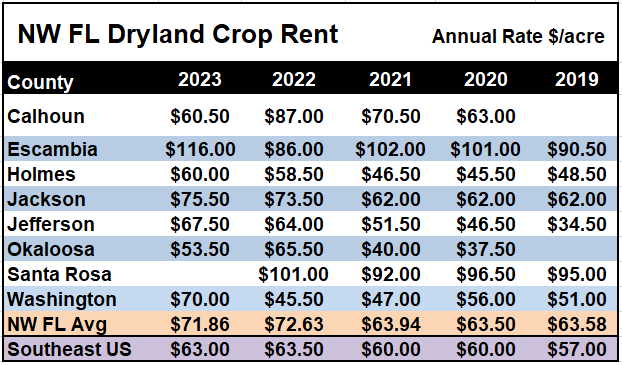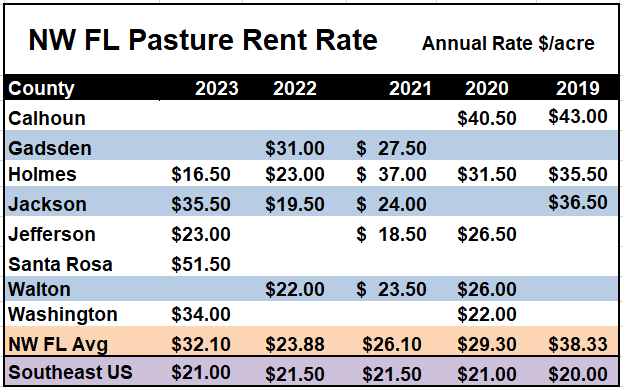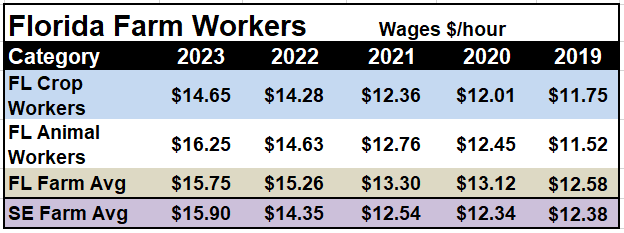
Negotiating farm lease agreements can be awkward but knowing USDA’s reported average rates is a good place to start. Credit: Tyler Jones, UF/IFAS
Discussions about money can be awkward in almost every type of relationship, but even more so between landowners and farmers, or employers and employees. As we begin 2024, many farmers and landowners have begun discussions about renewing leases and farmland rental agreements. It is also a good time of the year to think about worker benefits and wages. One of the easiest places to start thinking about how much to pay or charge is to find out the reported averages. As with all statistics, just knowing the average is only part of the story, but at least it offers an unbiased reference point for both parties to begin those awkward conversations.
–
Farmland Rental Rates
The USDA’s National Agricultural Statistic Service (NASS) annually surveys farm owners/managers to provide average land rental rates. Unfortunately their survey summary does not offer the range of rates paid, but does offer county, state, and regional averages.
The following is a summary of the information NASS provided for Northwest Florida from 2023 surveys. The rates reported were the annual rate per acre, so these are not monthly rates. Table 1 provides the average rate per acre for renting non-irrigated, dryland, or rain-fed crop land by county. The average rental rates in 2023 ranged from $53.50/acre to $116/acre, with an average of $71.86 for the seven Panhandle Counties in the NASS report. For the Southeastern sates, the average dryland crop rental rate was $63.00/acre.

Table 1. Source USDA/NASS Survey https://quickstats.nass.usda.gov/
–
NASS no longer provides an irrigated farmland rental report for most counties, but did provide data from Jackson again this year. Table 2 provides a Florida average rate of $267/acre and a rate for Southeastern States of $224/acre in 2023. This Florida average is influenced by a wide range of production systems including vegetables and citrus, so that is why there is such variation with the Jackson and SE Region averages. It is clear to see that farmers value irrigated land because of the stability and productivity of irrigated crop yields compared to dry-land (rain-fed) farm acres.

Table 2. Source USDA/NASS Survey https://quickstats.nass.usda.gov/
–
Pasture rental rates are significantly lower than for crop production. Considering it requires two or more acres/ cow-calf pair or horse, these rental rates reflect the lower returns per acre from livestock as compared to crops. Table 3 provides average rates by county in Northwest Florida in 2023. The average in Northwest Florida was $32.10/acre as compared to $21.00 across the Southeastern U.S.

Table 3. Source USDA/NASS Survey https://quickstats.nass.usda.gov/
–
Lease Agreements
I would certainly recommend that lease agreements are made in writing with copies made for both parties, especially when making agreements for multiple years. UF/IFAS Extension does not have a sample template for lease agreements, but I created a basic form from a Tennessee Extension document and have found some others from other states that also provide good examples. Lease agreements do not have to be developed by a lawyer or even notarized, but can be to make them stronger legal documents, in case of a dispute. The main thing that needs to be clear to both parities are the annual lease rate per acre, the number of acres being leased, and the date when payment is do annually. Not every acre of the property can be farmed, so it may well be that only part of the property is leased.
The other thing that is vital is to spell out any expectations from either party. Things to consider include: Who has permission to access the property? Farmer, employees, and immediate family members or simply associates of the lessee. Don’t forget to include landowner associates that might also be allowed access. These last few questions might not even be needed if there is a locked gate that provides locks for both parties or keys for both parties. Who is responsible for maintenance? What specifically requires maintenance and how frequently? What specific rights does the lessee (tenant) have? Use only for commercial farm operations or are recreational rights such as fishing and hunting included? The University of Tennessee has a nice publication that outlines what should be considered for farm leases: Introduction to Farmland Leasing.
The following are links to documents that might be helpful, just utilize them for what is most important to both parties and don’t over complicated the agreement.
Basic Farm Lease Agreement Form (word document to download and customize – adapted from UT Extension Farm Lease Agreement Form)
Basic Pasture Lease Form (NC State Extension)
Ag101 Cash Farm Lease (online fillable form provided North Central Farm Management Extension Committee)
Ag 101 Pasture Lease (online fillable form provided North Central Farm Management Extension Committee)
–
Farm Worker Wages
NASS does not provide worker wages at the county level, but only reports rates in general categories for Florida and the Southeast Region. The average farm worker wage was $15.75 across all of Florida, but was $15.90for the Southeast Region in 2023.

Table 4. Source USDA/NASS Survey https://quickstats.nass.usda.gov/
–
The U.S. average for all hired farm workers was $18.81 in October 2023, which was a 6% increase from 2022. NASS also provides a breakdown of average farm-worker wages by occupational classification at the national level. In Table 5 below, you can see how wages have changed compared to last year. In October 2023, U.S. farmers/ranchers/managers earned an average of $29.35/hr, labor supervisors $25.95/hr, equipment operators $19.00/hr, with farm and ranch workers an average rate of $17.00.

Table 6. Source NASS Farm Labor Report
–
References:
The USDA’s National Agricultural Statistic Services (NASS) offers a wide range of additional information based on annual surveys, as well as the Census of Agriculture every five years. To review the data available for your county, district, state, or region, use the following link: http://quickstats.nass.usda.gov/
US Farm Worker wage rate summaries were provided from the 2023 NASS Farm Labor Report
- 1st Quarter 2024 Weather Summary & Planting Season Outlook - April 26, 2024
- Friday Feature:Peanut Season Kicks Off at McArthur Farms - April 26, 2024
- Friday Feature:Artificial Intelligence in a Weed Control Machine - April 19, 2024
